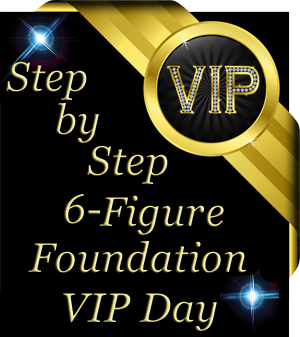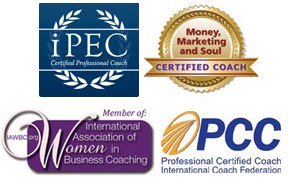5 Steps to Creating Juicy Business Packages that Sell
Hello and welcome! What you’ll find in this template is a step-by-step system that walks you through the process of creating your very own Juicy Business Packages that your clients will eagerly pay for!
There are a few things you’ll want to do to prepare. Start by arranging at least an hour of uninterrupted time to create your packages. Make sure you have a large pad of paper and a pen, and have your computer open to a blank Word doc.
Rustle up a standard size, or larger, pad of “sticky notes,” and a stack of index cards. Oh, and don’t forget your favorite cup of coffee, tea, or drink of choice!
Ready? Ok, let’s get going!
Step 1:
Take your time on this step, it’s very important. The more thorough you are, the juicier your packages will be!
Brainstorm every single thing you do for your clients. Or, if you’re new, brainstorm everything you anticipate doing for your clients. I’ve given you a comprehensive list of over 30 possibilities below. Read each one thoughtfully, and allow it to spark your imagination.
1. List every physical item you offer, or plan to offer. This includes:
- worksheets ,workbooks or manuals
- templates
- resource lists
- Journals to record progress in
- written assignments
- audio recordings
- video recordings
- meditations
- Articles
- ecourses
- ebooks
- Needs assessments
- Personality or work-style assessments
- Manifestos
- Questionaires and surveys on relevant topics, with overall results sent to them when complete
- Paperback or hard copy books (sent monthly or quarterly)
- Done-for-you copywriting, prepared marketing materials, newsletters, articles, etc.
- Access to and permission to use your own written promotional copy and materials that they may adjust to fit their needs.
- An invitation or a ticket to one of your events or someone else’s event
- Discounts on your other products and services
- Other information products of yours, or of someone else’s
- Subscription to something relevant to them, e.g. a magazine or periodical
- Special gifts, e.g. candles, rocks, magnets, notepads, etc. with inspirational words or quotes
- And anything else you can think of!
2. Then list every service you offer, or plan to offer, including:
- Consults
- Coaching or mentoring calls
- Training sessions
- In-person seminars, workshops & talks
- On-line webinars and teleseminars
- Virtual or in-person VIP days or retreats
- Recordings of private sessions or trainings
- On-line chat support
- Email support
- Phone support on an “as-needed” basis (divide quick, 10-15 minute laser calls and longer, as needed, calls in to 2 different categories, if offered)
- On-line participation by you in private forums for clients
- Reading client progress Journals
- Visibility on your website, in your newsletter, on a teleseminar, or at a live event.
- Role-playing important conversations with you for practice & feedback
- Writing, editing assistance and feedback for important emails, letters, or any type of marketing and promotional copy.
- Accountability follow-up
- Expedited turn-around time on delivery of products or services
- VIP status, with special privileges and gifts
- Extra VIP Mastermind opportunity added on to a teleseminar series as an extra call, or to a workshop or retreat as an extra day or evening (could be a special dinner)
- Attendance by a spouse, partner or key employee at retreats or events
- Attendance at any other workshops or seminars you offer for the duration of their program.
- Priority consideration for your other offers
- Promotional opportunities to your list (if appropriate)
- Guest experts at any teleseminars or live events you host
- Guest expert services included with their program
- Contests or sweepstakes with announced winners
- Client-only newsletters or special articles sent regularly
- Guest blog posts from them sent to your list and posted on your blog
- Interviews with them sent to your list and posted on your blog
- Anything you do as a special added “perk” that you just “throw in,” or think of, as being “just part of what you do for your clients, doesn’t everyone?” (No, everyone probably doesn’t!)
- Any of the above that can be presented as a group offering as well as a private offering.
- Anything you resent having given your clients after the fact, no matter how small, is something that should be on this list!
It’s important to note that most coaches and experts tend to undervalue “access to them,” and “turn-around time.” Yet those are two of the most powerful ways to offer value to your clients while leveraging your time spent.
It’s of immense value to a client to have the comfort of knowing you are available to them, if they need you for on-the-spot questions or challenges.
Even if they don’t use this perk or use it often, they will pay to know it is there. And 10 minutes on the phone to help someone in an immediate situation is worth many times more than that same help on a casual basis.
The same is true for turn-around time. Many experts think it’s “just good business” to turn around products or services quickly. To a certain degree, that’s true. But people will pay for speed. They will pay to save time. So save the fastest service for those willing to pay well for it, and include it in your list.
Step 2:
Decide how many packages you want to create, and what type. Typically, if you are a coach or an expert, you’ll be offering graduated packages at different price levels. My recommendation is to do it this way, if at all possible. It’s very effective to create a high-end package, a medium package, and a “dip your toe in the water” package.
If you’re just getting started, two packages are fine, and your medium package might even be a VIP day or retreat, with your high-end package containing multiple elements. You’re still going to be leveraging your time by offering value instead of mainly your time!
If you have a business where offering specialty packages distinguished mainly by content rather than price makes more sense, then of course you may be creating more than 2 or 3, which is fine.
Step 3:
Decide on the system you want to use to create your packages.
The idea is to create “buckets” that represent the number of packages you’ve decided upon. The key is to be able to move offers around from one bucket to another and to rearrange until you’re satisfied.
Here are some examples of “buckets” that work:
- Write each different physical item and service you offer on a sticky note. Use a separate sticky note to label each package and post them on a blank wall with room underneath for your offers.
- Use the same principle, but write on index cards instead of sticky notes, and lay them out on a large table instead of a vertical wall.
- Create a document in Word with columns to represent your package “buckets.” Type your offers in the appropriate columns as you go along, cutting and pasting as needed when switching around.
Step 4:
Now you’re going to begin to organize your products and services into packages.
A. Start by looking at the offers you feel are basic and necessary to your service, whatever the level is. You’ll need to copy that offering using your bucket system so you can add it to every one of your buckets. Do that now.
B. If you are distinguishing your packages by price, you’re going to want to include everything that’s in the lower-end package(s) in your higher package(s). You don’t want someone choosing a lower-end package because it contains something your premium package doesn’t!
In other words, each package will include everything in the package below it, plus more. The best way I’ve found to do this is to start with your highest end package, then as you move downward, carve out items out. So right now, add all the bells and whistles you want into your premium package.
C. Get excited! Take a look at all the great stuff your clients will be getting, and notice how it’s not all about you trading your “time for dollars.” You’re offering lots of value clients will pay for, because they’ll be getting the results they want – and you’ll be earning good money while investing less time!
D. Now, carve out the components from your premium offer that you want to offer in your lower package(s). Here are some ideas for those packages:
- Offer a 3 or 5 hour VIP day that kicks off your premium package, but can also be offered a la carte.
- Reduce the private access to you. This is very important – access to you in the form of personal, private time is your most valuable inventory. Save most of it for your premium package. This includes private phone time, email time, training time, etc.
- Increase the turn-around time. Save the fastest turn-around for your premium clients.
- Offer group versions of your private, high-end offerings. Instead of private coaching or consulting, offer question and answer forums to do spotlight coaching or training. Remember to include the group participation opportunities in your high-end, private package.
- Offer journaling opportunities for clients to send to you to read: it’s very helpful to them, and it doesn’t take much of your time to read them. You don’t need to respond, or if you do, a couple of sentences are fine.
Now, study the buckets and rearrange as you like. Make sure that each level is distinct from the others, in your time, your service or both.
Be careful not to give away so much in your lowest level package that you don’t have enough juicy offers for your higher level(s). Keep going until you feel satisfied with your juicy packages!
Step 5:
Name your packages. Choose a theme to name them, or else use names specific to your business. Stick with names that are tasteful and clearly fit the levels. Here are some ideas to use on their own, or to combine with your business:
- Platinum/Gold/Silver
- Diamond/Ruby/Emerald
- Mastery/Savvy/Jumpstart
- Expert/Professional/Start-up
Additional Tips:
- Consider separating and offering a few items as bonuses, preferably items that aren’t available to the client any other way. Add a suggested value to the bonus. This increases the overall feeling of value to the package.
- When offering your packages to a potential client, remember not to place too much emphasis on the logistics or the structure of the package, which is what you’re creating here. Focus mainly on the results clients will achieve. Then go over the structure and items in the package.
- Don’t start with your lowest package when describing your packages to clients. It’s much better to start at the top and move down, taking benefits away, rather than beginning at the bottom and adding on.
If you need help pricing your packages, I’d be happy to help you do that at no charge in one of my FREE “Jumpstart your Business Discovery Sessions.” To apply, simply click here.






